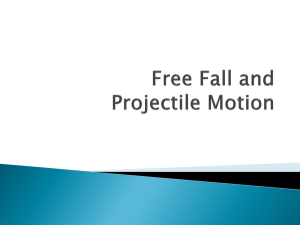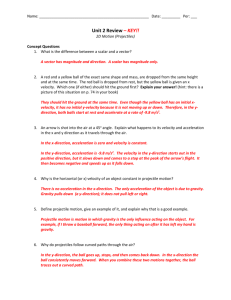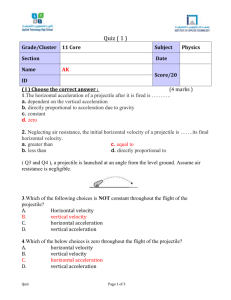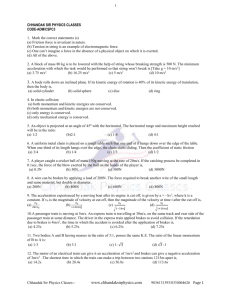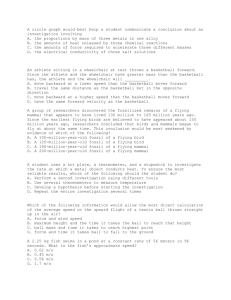Physics - Cardiff International School Dhaka
advertisement
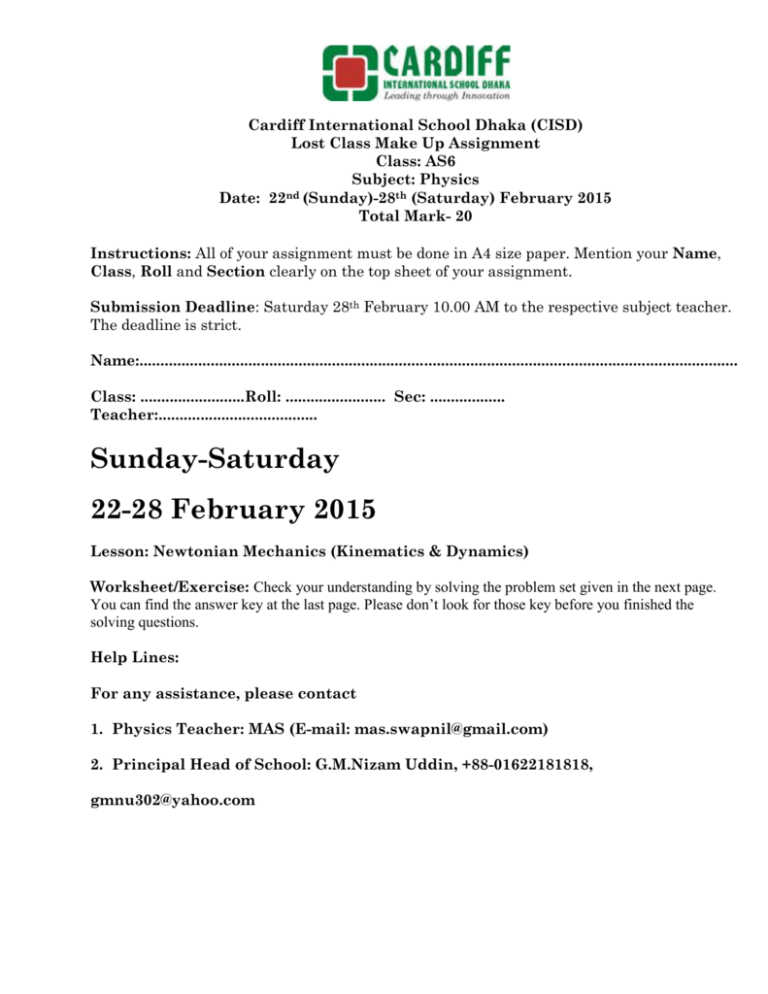
Cardiff International School Dhaka (CISD) Lost Class Make Up Assignment Class: AS6 Subject: Physics Date: 22nd (Sunday)-28th (Saturday) February 2015 Total Mark- 20 Instructions: All of your assignment must be done in A4 size paper. Mention your Name, Class, Roll and Section clearly on the top sheet of your assignment. Submission Deadline: Saturday 28th February 10.00 AM to the respective subject teacher. The deadline is strict. Name:............................................................................................................................................... Class: .........................Roll: ........................ Sec: .................. Teacher:...................................... Sunday-Saturday 22-28 February 2015 Lesson: Newtonian Mechanics (Kinematics & Dynamics) Worksheet/Exercise: Check your understanding by solving the problem set given in the next page. You can find the answer key at the last page. Please don’t look for those key before you finished the solving questions. Help Lines: For any assistance, please contact 1. Physics Teacher: MAS (E-mail: mas.swapnil@gmail.com) 2. Principal Head of School: G.M.Nizam Uddin, +88-01622181818, gmnu302@yahoo.com Kinematics & Dynamics 1. A particle is moving in a straight line with uniform acceleration. Which graph represents the motion of the particle? [C] 2. A pendulum bob is held stationary by a horizontal force H. The three forces acting on the bob are shown in the diagram. The tension in the string of the pendulum is T. The weight of the pendulum bob is W. Which statement is correct? A H = T cos30° B T= H sin30° C W = T cos30° D W = T sin30° 3. What is meant by the weight of an object? A the gravitational field acting on the object B the gravitational force acting on the object C the mass of the object multiplied by gravity D the object’s mass multiplied by its acceleration 4. A projectile is launched at point O and follows the path OPQRS, as shown. Air resistance may be neglected. Which statement is true for the projectile when it is at the highest point Q of its path? A The horizontal component of the projectile’s acceleration is zero. B The horizontal component of the projectile’s velocity is zero. C The kinetic energy of the projectile is zero. D The momentum of the projectile is zero. 5. Two markers M1 and M2 are set up a vertical distance h apart. When a steel ball is released from rest from a point a distance x above M1, it is found that the ball takes time t1 to reach M1 and time t2 to reach M2. Which expression gives the acceleration of the ball? [D] 6. A body falls from rest in a vacuum near the Earth’s surface. The variation with time t of its speed v is shown below. [D] Which graph shows the variation with time t of the speed v of the same ball falling in air at the same place on Earth? 7. Two spheres A and B approach each other along the same straight line with speeds uA and uB. The spheres collide and move off with speeds vA and vB, both in the same direction as the initial direction of sphere A, as shown below. Which equation applies to an elastic collision? [D] 8. Two equal masses travel towards each other on a frictionless air track at speeds of 60 cm/s and 30 cm/s. They stick together on impact. What is the speed of the masses after impact? [A] 9. Which of the following pairs of forces, acting on a circular object, constitutes a couple? [A] 10. The diagrams represent systems of coplanar forces acting at a point. The lengths of the force vectors represent the magnitudes of the forces. Which system of forces is in equilibrium? [A] 11. A uniform metre rule of mass 100 g is supported by a knife-edge at the 40 cm mark and a string at the 100 cm mark. The string passes round a frictionless pulley and carries a mass of 20 g as shown in the diagram. At which mark on the rule must a 50 g mass be suspended so that the rule balances? A 4cm B 36 cm C 44 cm D 96 cm 12. Two forces, each of 10 N, act at a point P as shown in the diagram. The angle between the directions of the forces is 120°. What is the magnitude of the resultant force? A 5N B 10N C 17N D 20N 13. A projectile is fired at an angle 𝛼 to the horizontal at a speed u, as shown. [C] What will be the vertical and horizontal components of its velocity after a time t? Assume that air resistance is negligible. The acceleration of free fall is g. 14. The graph of velocity against time for an object moving in a straight line is shown. [C] Which of the following is the corresponding graph of displacement against time? 15. A ball is released from rest above a horizontal surface. The graph shows the variation with time of its velocity. Areas X and Y are equal. This is because A the ball’s acceleration is the same during its upward and downward motion. B the speed at which the ball leaves the surface after an impact is equal to the speed at which it returns to the surface for the next impact. C for one impact, the speed at which the ball hits the surface equals the speed at which it leaves the surface. D the ball rises and falls through the same distance between impacts. 16. Two blocks X and Y, of masses m and 3m respectively, are accelerated along a smooth horizontal surface by a force F applied to block X as shown. [D] What is the magnitude of the force exerted by block X on block Y during this acceleration? 17. A car with front-wheel drive accelerates in the direction shown. [C] Which diagram best shows the direction of the total force exerted by the road on the front wheels? 18. The diagram shows four forces applied to a circular object. Which of the following describes the resultant force and resultant torque on the object? [B] 19. A balloon is acted upon by three forces, weight, upthrust and sideways force due to the wind, as shown in the diagram. What is the vertical component of the resultant force on the balloon? A 500 N B 1000 N C 10 000 N D 10 500N 20. A ball falls from rest through air and eventually reaches a constant velocity. For this fall, forces X and Y vary with time as shown. What are forces X and Y? [C] 21. A force of 5 N may be represented by two perpendicular components OY and OX as shown in the diagram, which is not drawn to scale. OY is of magnitude 3 N. What is the magnitude of OX? A 2N B 3N C 4N D 5N 22. A car at rest in a traffic queue moves forward in a straight line and then comes to rest again. The graph shows the variation with time of its displacement. What is its speed while it is moving? [B] 23. An object is dropped from a great height and falls through air of uniform density. The acceleration of free fall is g. Which graph could show the variation with time t of the acceleration a of the object? [A] 24. Which of the following is a statement of the principle of conservation of momentum? A Momentum is the product of mass and velocity. B In an elastic collision, momentum is constant. C The momentum of an isolated system is constant. D The force acting on a body is proportional to its rate of change of momentum. 25. A mass accelerates uniformly when the resultant force acting on it A is zero. B is constant but not zero. C increases uniformly with respect to time. D is proportional to the displacement from a fixed point. 26. A molecule of mass m travelling horizontally with velocity u hits a vertical wall at right angles to the wall. It then rebounds horizontally with the same speed. What is its change in momentum? A zero B mu C –mu D –2mu 27. A spanner is used to tighten a nut as shown. A force F is applied at right-angles to the spanner at a distance of 0.25 m from the centre of the nut. When the nut is fully tightened, the applied force is 200 N. What is the resistive torque, in an anticlockwise direction, preventing further tightening? A 8Nm B 25Nm C 50Nm D 800Nm 28. Two parallel forces, each of magnitude F, act on a body as shown. What is the magnitude of the torque on the body produced by these forces? A Fd B Fs C 2Fd D 2Fs 29. A force F is applied to a freely moving object. At one instant of time, the object has velocity v and acceleration a. Which quantities must be in the same direction? A a and v only B a and F only C v and F only D v, F and a 30. A hinged door is held closed in the horizontal position by a cable. Three forces act on the door: the weight W of the door, the tension T in the cable, and the force H at the hinge. Which list gives the three forces in increasing order of magnitude? A H,T,W B T,H,W C W,H,T D W,T,H




